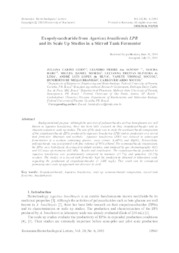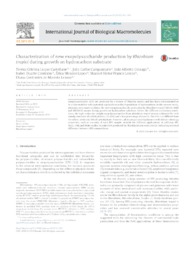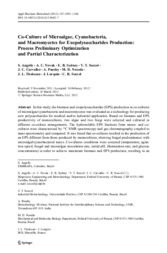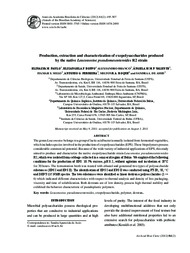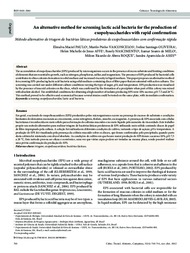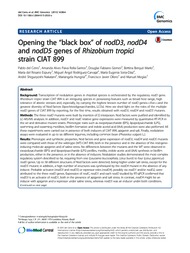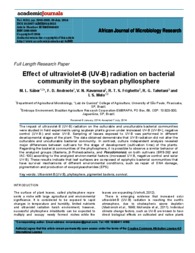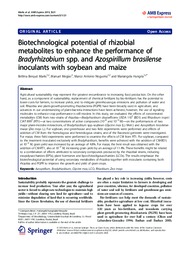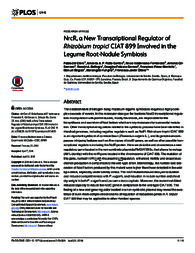Busca de Publicações
Filtrar por:
| Autoria: GERN, J. C.; SANTOS, L. F. dos; HABU, S.; NOSEDA, M. D.; LIMA, L. F. O. de; SILVA, A. L. L. da; SOCCOL, V. T.; BRANDAO, H. de M.; SOCCOL, C. R. Background and purpose: Although the activities of polysaccharides such as beta-glucans are well known in Agaricus brasiliensis, there has been little research on their exopolysaccharides and its char... ... |
| Autoria: CASTELLANE, T. C. L.; CAMPANHARO, J. C.; COLNAGO, L. A.; COUTINHO, I. D.; LOPES, E. M.; LEMOS, M. V. F.; LEMOS, E. G. M.
|
| Autoria: ANGELIS, S. de; NOVAK, A. C.; SYDNEY, E. B.; SOCCOL, V. T.; CARVALHO, J. C.; PANDEY, A.; NOSEDA, M. D.; THOLOZAN, J. L.; LORQUIN, J.; SOCCOL, C. R. In this study, the biomass and exopolysaccharides (EPS) production in co-cultures of microalgae/cyanobacteria and macromycetes was evaluated as a technology for producing new polysaccharides for medic... ... |
| Autoria: PAULO, E. M.; BOFFO, E. F.; BRANCO, A.; VALENTE, A. M. M. P.; MELO, I. S. de; FERREIRA, A. G.; ROQUE, M. R. de A.; ASSIS, S. A. de ABSTRACT: The genus Leuconostoc belongs to a group of lactic acid bacteria usually isolated from fermented vegetables, which includes species involved in the production of exopolysaccharides (EPS). Th... ... |
| Autoria: PAULO, E. M.; VASCONCELOS, M. P.; OLIVEIRA, I. S.; AFFE, H. M. J.; NASCIMENTO, R. dos S.; MELO, I. S. de; ROQUE, M. R. de A.; ASSIS, S. A. de Abstract: The accumulation of exopolysaccharides (EPS) produced by microorganisms occurs in the presence of excess substrate and limiting conditions of elements that are essential to growth, such as n... ... |
| Autoria: KIELAK, A. M.; CASTELLANE, T. C. L.; CAMPANHARO, J. C.; COLNAGO, L. A.; COSTA, O. Y. A.; SILVA, M. L. C.; VAN VEEN, J. A.; LEMOS, E. G. M.; KURAMAE, E. E.
|
| Autoria: CERRO, P. del; ROLLA-SANTOS, A. A. P.; GOMES, D. F.; MARKS, B. B.; ESPUNY, M. del R.; RODRÍGUEZ-CARVAJAL, M. A.; SORIA-DÍAZ, M. E.; NAKATANI, A. S.; HUNGRIA, M.; JAVIER OLLERO, F.; MEGÍAS, M. Transcription of nodulation genes in rhizobial species is orchestrated by the regulatory nodD gene. Rhizobium tropici strain CIAT 899 is an intriguing species in possessing features such as broad host... ... |
| Autoria: SÁBER, M. L.; ANDREOTE, F. D.; KAVAMURA, V. N.; FRIGHETTO, R. T. S.; TAKETANI, R. G.; MELO, I. S. de Abstract: The impact of ultraviolet-B (UV-B) radiation on the culturable and unculturable bacterial communities were studied in field experiments using soybean plants grown under increased UV-B (UV-B+... ... |
| Autoria: MARKS, B. B.; MEGÍAS, M.; NOGUEIRA, M. A.; HUNGRIA, M. Agricultural sustainability may represent the greatest encumbrance to increasing food production. On the other hand, as a component of sustainability, replacement of chemical fertilizers by bio-fertil... ... |
| Autoria: CERRO, P. del; ROLLA-SANTOS, A. A. P.; VALDERRAMA-FERNANDEZ, R.; GIL-SERRANO, A.; BELLOGÍN, R. A.; GOMES, D. F.; MONTAÑO, F. P.; MEGÍAS, M.; HUNGRIA, M.; JAVIER OLLERO, F. The establishment of nitrogen-fixing rhizobium-legume symbioses requires a highly complex cascade of events. In this molecular dialogue the bacterial NodD transcriptional regulators in conjunction wit... ... |
Observações
1 - Por padrão são exibidas publicações dos últimos 20 anos. Para encontrar publicações mais antigas, configure o filtro ano de publicação, colocando o ano a partir do qual você deseja encontrar publicações. O filtro está na coluna da esquerda na busca acima.
2 - Para ler algumas publicações da Embrapa (apenas as que estão em formato ePub), é necessário ter, no celular ou computador, um desses softwares gratuitos. Sistemas Android: Google Play Livros; IOS: iBooks; Windows e Linux: software Calibre.
Acesse outras publicações
Acesse a Base de Dados da Pesquisa Agropecuária (BDPA) para consultar o acervo completo das bibliotecas da Embrapa.

